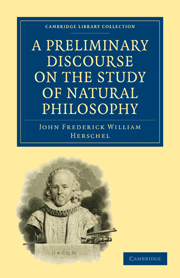Book contents
- Frontmatter
- Contents
- Dedication
- PART I OF THE GENERAL NATURE AND ADVANTAGES OF THE STUDY OF THE PHYSICAL SCIENCES
- PART II OF THE PRINCIPLES ON WHICH PHYSICAL SCIENCE RELIES FOR ITS SUCCESSFUL PROSECUTION, AND THE RULES BY WHICH A SYSTEMATIC EXAMINATION OF NATURE SHOULD BE CONDUCTED, WITH ILLUSTRATIONS OF THEIR INFLUENCE AS EXEMPLIFIED IN THE HISTORY OF ITS PROGRESS
- PART III OF THE SUBDIVISION OF PHYSICS INTO DISTINCT BRANCHES, AND THEIR MUTUAL RELATIONS
- CHAP. I Of the Phenomena of Force, and of the Constitution of Natural Bodies
- CHAP. II Of the Communication of Motion through Bodies. — Of Sound and Light
- CHAP. III Of Cosmical Phenomena
- CHAP. IV Of the Examination of the material Constituents of the World
- CHAP. V Of the Imponderable Forms of Matter
- CHAP. VI Of the Causes of the actual rapid Advance of the Physical Sciences compared with their Progress at an earlier Period
- Index
CHAP. II - Of the Communication of Motion through Bodies. — Of Sound and Light
Published online by Cambridge University Press: 29 August 2010
- Frontmatter
- Contents
- Dedication
- PART I OF THE GENERAL NATURE AND ADVANTAGES OF THE STUDY OF THE PHYSICAL SCIENCES
- PART II OF THE PRINCIPLES ON WHICH PHYSICAL SCIENCE RELIES FOR ITS SUCCESSFUL PROSECUTION, AND THE RULES BY WHICH A SYSTEMATIC EXAMINATION OF NATURE SHOULD BE CONDUCTED, WITH ILLUSTRATIONS OF THEIR INFLUENCE AS EXEMPLIFIED IN THE HISTORY OF ITS PROGRESS
- PART III OF THE SUBDIVISION OF PHYSICS INTO DISTINCT BRANCHES, AND THEIR MUTUAL RELATIONS
- CHAP. I Of the Phenomena of Force, and of the Constitution of Natural Bodies
- CHAP. II Of the Communication of Motion through Bodies. — Of Sound and Light
- CHAP. III Of Cosmical Phenomena
- CHAP. IV Of the Examination of the material Constituents of the World
- CHAP. V Of the Imponderable Forms of Matter
- CHAP. VI Of the Causes of the actual rapid Advance of the Physical Sciences compared with their Progress at an earlier Period
- Index
Summary
(269.) The propagation of motion through all substances, whether of a single impulse, as a blow or thrust, or of one frequently and regularly repeated, such as a jarring or vibratory movement, depends wholly on these molecular forces; and it is on such propagation that sound and very probably light depend. To conceive the manner in which a motion may be conveyed from one part of a substance to another, whether solid or fluid, we may attend to what takes place when a wave is made to run along a stretched string, or the surface of still water. Every part of the string, or water, is in succession moved from its place, and agitated with a motion similar to that of the original impulse, leaving its place and returning to it, and when one part ceases to move the next receives as it were the impression, and forwards it onward. This may seem a slow and circuitous process in description; but when sound, for example, is Conveyed through the air, we are to consider, 1st, that the air, the substance actually in motion, is extremely light and acted upon by a very powerful elasticity, so that the force which propagates the motion, or by which the particles adjacent act on, and urge forward, each other, is very great, compared with the quantity of materials set in motion by it: and the same is true, even in a greater degree, in liquids and solids; for in these the elastic forces are even greater, in proportion to the weight, than in air.
Information
- Type
- Chapter
- Information
- A Preliminary Discourse on the Study of Natural Philosophy , pp. 246 - 264Publisher: Cambridge University PressPrint publication year: 2009First published in: 1830
